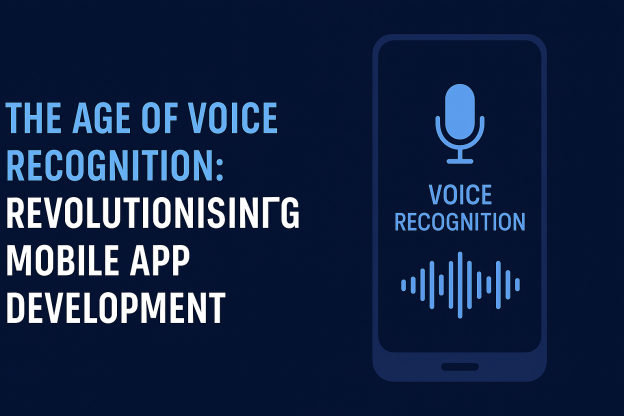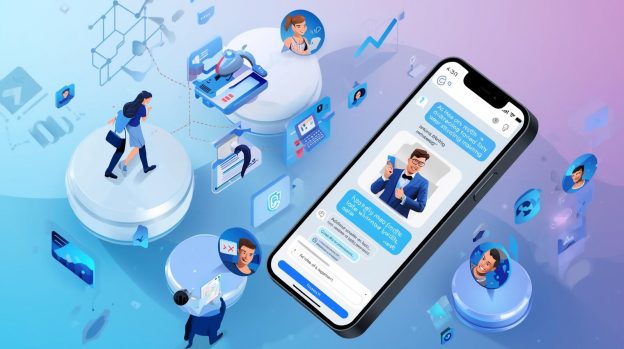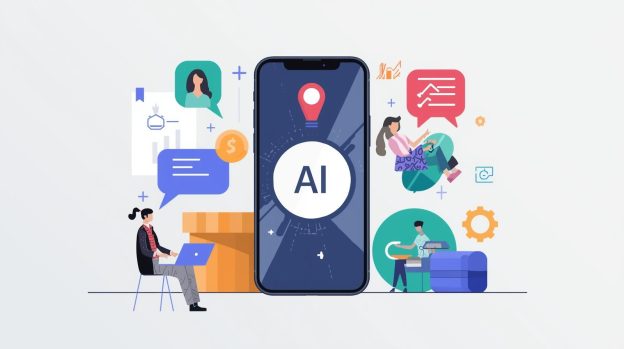The Age of Voice Recognition: Revolutionising Mobile App Development

One in five people use voice search regularly. The stats indicate that there were approximately 8.4 billion active voice assistants in 2024. We use our voice to communicate with our digital devices by giving instructions and having conversations. What makes it possible? The answer is Voice Recognition Technology.
Although voice recognition and speech recognition are slightly different aspects of the same technology. Speech recognition converts the speech into text form, and its focus is on “what” users say. On the other hand, voice search focuses on identifying ‘who’ is speaking. The voice recognition technology recognises unique vocal characteristics of the individual. Through this, voice recognition allows seamless and unique authentication by matching ‘voice’.
In this article, we will explore the impact of voice recognition technology on diversifying mobile apps. Users today are becoming increasingly aware of what a smartphone is and what a mobile app is, even without inherent knowledge. This is a good sign considering that digital literacy in India was poor up until a decade ago. It has become possible because of voice recognition technology. In India, people use smartphones to search for a service, look for products, find directions, etc. These are some of the major functions that make smartphones ‘smart’.
Voice Recognition technology is helping India advance by providing increased accessibility, overcoming language barriers, and increasing engagement. Let’s dive into understanding how Voice recognition is revolutionising the mobile app development landscape.
Why Should Mobile App Development Include Voice Recognition Technology?
Gartner said, “By 2020, 30% of web browsing sessions will be done without a screen”. We are now way past this timeline, and voice/speech recognition has indeed taken over in terms. Over 60% of people use voice search in India, as per an article.
People are increasingly using voice search and audio-centric technologies like Amazon’s Echo, Google Home and Apple’s AirPods. People are enjoying voice-first interactions using voice recognition technology. This technology extends the web experience to multiple activities like cooking, driving, etc. People can speak to their phone, ask questions, have a conversation, and open YouTube, along with other tasks.
Technology is making significant strides in 2025. The paramount changes in the world of digital tools and technologies give rise to plenty of opportunities. But it poses a threat to older websites and applications that do not use AI, such as voice recognition technology. The issue is that users leave traditional applications and websites behind that do not add value to their experience. It’s not that traditional/older apps don’t provide anything useful now. They just lack the smart features like voice and speech recognition, impacting the user experience. Many applications, like banking apps and healthcare apps, use voice recognition technology to authenticate users. It is a strong layer of security which protects users against cyberattacks.
Let’s see how voice recognition works in mobile applications and the way it helps users enhance their digital experience –
Enhanced User Experience
Voice recognition/speech recognition technology provides a hands-free approach to users. But what does it mean? A hands-free approach is simply that you don’t need to touch your phone physically. Voice assistants like Siri and Google Assistant have instant voice activation. So even when you are stuck in other activities, be it driving, cooking, eating, jogging, etc., you can access your phone through voice/speech recognition.
In addition to that, speaking is already faster than typing. There are no language barriers for you to face. You can go right ahead and converse with your voice assistant to ask for directions or to help you in cooking in whichever language you like. The user experience just gets better with voice recognition technology as it allows faster task completion. Among several tasks that you can do using voice recognition, it provides seamless access to complex navigation in apps. With improved navigation, faster searching, and intuitive interaction, users find voice recognition their go-to approach over texted interactions.
Increased Productivity and Streamlined Operations
Did you know that voice recognition technology existed even before AI? Previously, the systems were only able to understand a few digits or words. Since the introduction of AI, digital devices, apps and websites are becoming more advanced in terms of streamlining operations and increasing productivity.
As we discussed earlier, voice recognition technology expedites tasks like searching, finding locations, texting, etc. Voice command recognition is faster than typing manually and searching. It enables quick task completion and allows users to multitask. Your long messages do not have to wait for your speed to match up. You can send them through voice/speech recognition software, which enables sending messages with up to 95% accuracy. One of the top performers for dictation and speech-to-text related tasks is Dragon by Nuance. Apart from this, Alexa, Google Docs voice type, and Siri also have an optimum accuracy of speech-to-text.
Increased Accessibility
Voice recognition technology provides alternative input methods for individuals with visual impairments, ADHD, and other disabilities. Individuals in this bracket can access applications and digital devices more effectively using voice recognition technology. By enabling this technology in mobile apps, businesses can reach a more diverse audience. They can provide an accessibility guide on their respective apps and websites. This will help customers with disabilities become more aware of the services/products offered on the platform.
Personalisation
Voice recognition technology works on deep learning, where it can understand patterns and preferences of individuals through their interactions. Moreover, it also understands the nuances in the tone in which you ask questions or make conversation with AI.
Based on similar searches, your voice assistant provides effective recommendations which match your preferences. If you interact with your Google Assistant frequently, it will give you personalised responses. For example, Google Voice Assistant asks you about your day or simply “How are you”, which helps you feel personally connected to the AI voice.
Enhanced Security
Voice recognition technology provides a new layer of security for your banking applications. This technology is one of the most readily accepted measures of security due to its contactless nature. However, the voice recognition-based security may not be strong enough since the technology advancements are still underway. Developers can make voice technology a part of a multifactor authentication mechanism. It can become an effective and significant security measure for mobile apps.
Real-Life Applications of Voice Recognition Technology with Examples
Personal Assistants and Smart Devices
Voice search is the most prominent use of voice recognition technology. Personal assistants like Siri, Google Assistant and Alexa and voice-activated tools that make searching smooth and efficient. You can ask any questions to your assistants, and they will provide answers by searching the web. For example, if you ask the Google Assistant about the weather today, it will give you detailed insights into how weather conditions are looking in your location.
(Source: Mint, 2020)
Voice Commands for Smart Home Devices
Smart technology extends to smart home appliances as well. Voice assistants can help manage your smart appliances like smart AC, smart TV, smart lights, etc. With only a single voice command, you can control your smart home devices in any manner you like. For instance, Amazon’s Alexa is connected to more than 400 million smart home devices. Users can give instructions to Alexa to manage smart home appliances, like turning off the living room fan, turning on the bedroom AC, turning on the washing machine, etc.
Speech-to-text
The facilitation of hands-free writing is possible using a speech-to-text mechanism available in various applications. For example, Microsoft Word and Google Docs have a text-to-speech feature that allows seamless conversion from speech to text. The technology helps in writing emails, creating formal/informal documents or transcribing live meetings.
Voice Commands for Automobiles
Integration of voice recognition technology is also present in automotives. In-car speech recognition systems assist drivers with directions, parking, driving, and even initiating phone calls. They provide an enhanced user experience while driving. In addition to this, in-car speech systems have multilingual support that enables the voice assistant to understand different languages and dialects.
Education & Healthcare
Among various popular examples of voice recognition technology in ed-tech, Duolingo is the most famous. If you are not familiar with it, Duolingo provides free language learning on its platform. It provides courses in more than 40 languages. The application provides engaging lessons to users that help in learning grammar, vocabulary, and pronunciation.
Duolingo uses voice recognition technology to help users practice pronunciation. Another app, Elsa Speak, uses voice recognition to provide personalised feedback to users to help them learn English. In healthcare, doctors and their assistants do dictation of patient records using speech-to-text technology. Voice recognition in healthcare settings streamlines operations and enhances patient care.
Challenges in Voice Recognition Technology
Voice assistants have a lot of room for improvement. The challenge with this technology is that it keeps growing and refining. For instance, you must be aware of this phrase – “Sorry, can you say that again?” It happens when your voice assistant is not able to translate and convert your voice to speech. The issue of accuracy is one of the prominent challenges with voice recognition technology.
In addition to that, the employees at tier-1 companies like PwC cite the issue of privacy in using voice recognition systems. Users state that while the technology is effective at handling small day-to-day tasks, they cannot give it control over their sensitive data. It is also justified in the sense that AI practices are not completely transparent. Users have no idea what voice assistants do with the data they receive from users. Hence, trust is the only barrier for voice assistant users.
Final Verdict on Using Voice Recognition Technology in Mobile Apps
To use or not to use voice recognition technology is a question of need. If you are looking to grow your business by enabling better service to customers, voice recognition is for you. Integration of voice recognition technology for fast searching, resolving customer queries and providing 24/7 availability within your app will help boost sales. This is because the voice recognition integration into your application will guide users through the entire sales process.
For example, integration of a voice assistant chatbot in an e-commerce app increases accessibility, efficiency, engagement and creates a personalised experience. Your application will become more accessible to individuals with disabilities. In addition to that, the customers can search products using a hands-free approach.
To Sum Up
In a world of smart devices and smart applications, you need a smart strategy to integrate voice recognition technology into your app. Voice recognition enables better and faster search within the systems. It boosts customer engagement with the application, provides more productivity, and is convenient to use. Our developers at Vervelogic, a leading mobile app development company in Jaipur, are experienced in AI-powered app development. We would be thrilled to help you develop and finalise a strategy to integrate voice recognition technology within your application.
FAQs
What is the benefit of using chatbots in e-commerce?
Chatbots in e-commerce will provide 24/7 support to customers. They can handle a large number of queries simultaneously while also providing a personalised experience.
What is the difference between voice bots and chatbots?
Voice bots communicate through spoken language while chatbots communicate through text-based messages.
Do voice assistants use AI?
Yes, voice assistants like Alexa, Siri and Google Assistant use AI.
Can I add voice recognition technology to my application?
Yes, its integration depends on the desired functionality and the platform used to develop the app. There are cloud-based APIs available, along with the ChatGPT API, whose integration makes it possible to leverage its built-in recognition features.





